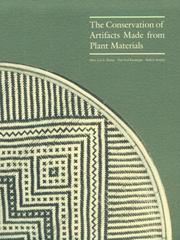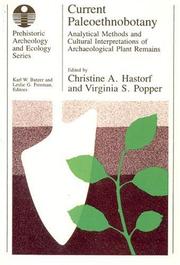| Listing 1 - 10 of 81 | << page >> |
Sort by
|
Book
ISBN: 9492444313 9789492444318 9789492444011 9492444011 Year: 2016 Publisher: Havertown Barkhuis Publishing
Abstract | Keywords | Export | Availability | Bookmark
 Loading...
Loading...Choose an application
- Reference Manager
- EndNote
- RefWorks (Direct export to RefWorks)
This study argues that early farming life may have been more multifaceted than previously thought, and puts forward a reinterpretation of the traditional views on farming, wild plant gathering and social relationships during the Neolithic in the North East of the Iberian Peninsula. 00The archaeobotanical data from 17 archaeological sites is presented (Sardo Cave; Camp del Colomer; Serra del Mas Bonet; La Dou Codella, 120; Cave La Draga; Bòbila Madurell; Carrer Reina Amàlia, 31?33; Prehistoric Mines of Gavà; Can Sadurní Cave; Sant Llorenç Cave; Espina C; Pla del Gardelo; Puig del Collet; CIM "El Camp"; Fosca Cave). For each site, pioneering methods of investigating the origin and the representativeness of the data are applied. Following these evaluations, palaeoeconomic issues are targeted at diff erent scales, ranging from the context to the regional level. The detailed investigations performed at the site of La Draga particularly stand out, as this is the only Neolithic site with waterlogged conditions of preservation in the Iberian Peninsula. Innovative data on the history of crops like tetraploid naked wheat, tworow barley, naked barley and opium poppy as well as on the role of wild fruits in the economy is revealed, completing an important piece in the puzzle of the investigations concerning the Neolithic in Europe.
Plant remains (Archaeology) --- Archaeobotanical assemblages --- Archaeobotanical material --- Archaeobotanical remains --- Archaeobotany --- Archaeological plant remains --- Archaeology, Botanical --- Assemblages, Archaeobotanical --- Botanical archaeology --- Botany in archaeology --- Material, Archaeobotanical --- Phytoarchaeology --- Remains, Archaeobotanical --- Remains, Plant (Archaeology) --- Remains, Vegetal (Archaeology) --- Vegetal remains (Archaeology) --- Archaeology --- Paleobotany --- Anthracology --- Methodology
Periodical
ISSN: 21624496 Year: 1981 Publisher: Flagstaff, Ariz. : Flagstaff, AZ : Center for Western Studies Society of Ethnobiology
Abstract | Keywords | Export | Availability | Bookmark
 Loading...
Loading...Choose an application
- Reference Manager
- EndNote
- RefWorks (Direct export to RefWorks)
Ethnobiology --- Plant remains (Archaeology) --- Animal remains (Archaeology) --- Ethnobiology. --- Folk biology --- Folkbiology --- Indigenous peoples --- Traditional biology --- Archaeobotanical assemblages --- Archaeobotanical material --- Archaeobotanical remains --- Archaeobotany --- Archaeological plant remains --- Archaeology, Botanical --- Assemblages, Archaeobotanical --- Botanical archaeology --- Botany in archaeology --- Material, Archaeobotanical --- Phytoarchaeology --- Remains, Archaeobotanical --- Remains, Plant (Archaeology) --- Remains, Vegetal (Archaeology) --- Vegetal remains (Archaeology) --- Archaeozoology --- Zooarchaeology --- Zoology in archaeology --- Biology, Economic --- Ethnoscience --- Archaeology --- Paleobotany --- Anthracology --- Bones --- Animal paleopathology --- Methodology
Book
ISBN: 0586082824 Year: 1978 Publisher: St. Albans Granada Publishing Limited - Paladin
Abstract | Keywords | Export | Availability | Bookmark
 Loading...
Loading...Choose an application
- Reference Manager
- EndNote
- RefWorks (Direct export to RefWorks)
archaeobotany --- Palaeobotany --- Archeology --- Prehistory --- Plant remains (Archaeology) --- Archaeobotanical assemblages --- Archaeobotanical material --- Archaeobotanical remains --- Archaeobotany --- Archaeological plant remains --- Archaeology, Botanical --- Assemblages, Archaeobotanical --- Botanical archaeology --- Botany in archaeology --- Material, Archaeobotanical --- Phytoarchaeology --- Remains, Archaeobotanical --- Remains, Plant (Archaeology) --- Remains, Vegetal (Archaeology) --- Vegetal remains (Archaeology) --- Archaeology --- Paleobotany --- Anthracology --- Methodology --- Plant remains (Archaeology).

ISBN: 0892361603 Year: 1992 Publisher: Princeton Paul Getty Trust
Abstract | Keywords | Export | Availability | Bookmark
 Loading...
Loading...Choose an application
- Reference Manager
- EndNote
- RefWorks (Direct export to RefWorks)
Botany --- Art --- Plant remains (Archaeology) --- Collection and preservation. --- Archaeobotanical assemblages --- Archaeobotanical material --- Archaeobotanical remains --- Archaeobotany --- Archaeological plant remains --- Archaeology, Botanical --- Assemblages, Archaeobotanical --- Botanical archaeology --- Botany in archaeology --- Material, Archaeobotanical --- Phytoarchaeology --- Remains, Archaeobotanical --- Remains, Plant (Archaeology) --- Remains, Vegetal (Archaeology) --- Vegetal remains (Archaeology) --- Archaeology --- Paleobotany --- Anthracology --- Methodology
Book
ISBN: 0860543390 Year: 1985 Volume: vol 266
Abstract | Keywords | Export | Availability | Bookmark
 Loading...
Loading...Choose an application
- Reference Manager
- EndNote
- RefWorks (Direct export to RefWorks)
Animal remains (Archaeology) --- -Plant remains (Archaeology) --- -Paleobiology --- -Palaeobiology --- Biology --- Paleontology --- Archaeobotanical assemblages --- Archaeobotanical material --- Archaeobotanical remains --- Archaeobotany --- Archaeological plant remains --- Archaeology, Botanical --- Assemblages, Archaeobotanical --- Botanical archaeology --- Botany in archaeology --- Material, Archaeobotanical --- Phytoarchaeology --- Remains, Archaeobotanical --- Remains, Plant (Archaeology) --- Remains, Vegetal (Archaeology) --- Vegetal remains (Archaeology) --- Archaeology --- Paleobotany --- Anthracology --- Congresses --- Methodology --- -Congresses --- Paleobiology --- Plant remains (Archaeology) --- Palaeobiology
Book
ISBN: 3786110425 9783786110422 Year: 1970 Volume: 4 10 Publisher: Berlin: Mann,
Abstract | Keywords | Export | Availability | Bookmark
 Loading...
Loading...Choose an application
- Reference Manager
- EndNote
- RefWorks (Direct export to RefWorks)
Plant remains (Archaeology) --- Archaeobotanical assemblages --- Archaeobotanical material --- Archaeobotanical remains --- Archaeobotany --- Archaeological plant remains --- Archaeology, Botanical --- Assemblages, Archaeobotanical --- Botanical archaeology --- Botany in archaeology --- Material, Archaeobotanical --- Phytoarchaeology --- Remains, Archaeobotanical --- Remains, Plant (Archaeology) --- Remains, Vegetal (Archaeology) --- Vegetal remains (Archaeology) --- Archaeology --- Paleobotany --- Anthracology --- Methodology --- Plant remains (Archaeology) - Germany (West) - Neuss
Book
ISBN: 2903148562 9782903148560 Year: 1989 Volume: 4 Publisher: Strasbourg : European Science Foundation, Standing Committee for the Humanities,
Abstract | Keywords | Export | Availability | Bookmark
 Loading...
Loading...Choose an application
- Reference Manager
- EndNote
- RefWorks (Direct export to RefWorks)
Plant remains (Archaeology) --- Handbooks, manuals, etc --- Handbooks, manuals, etc. --- Archaeobotanical assemblages --- Archaeobotanical material --- Archaeobotanical remains --- Archaeobotany --- Archaeological plant remains --- Archaeology, Botanical --- Assemblages, Archaeobotanical --- Botanical archaeology --- Botany in archaeology --- Material, Archaeobotanical --- Phytoarchaeology --- Remains, Archaeobotanical --- Remains, Plant (Archaeology) --- Remains, Vegetal (Archaeology) --- Vegetal remains (Archaeology) --- Archaeology --- Paleobotany --- Anthracology --- Methodology

ISBN: 0226318931 0226318923 Year: 1988 Publisher: Chicago University of Chicago press
Abstract | Keywords | Export | Availability | Bookmark
 Loading...
Loading...Choose an application
- Reference Manager
- EndNote
- RefWorks (Direct export to RefWorks)
Paleoethnobotany offers powerful tools for reconstructing past cultures by examining the interaction of human populations with the plant world. Plant remains from archaeological sites can provide information for a number of disciplines: archaeologists may use such remains to examine how plants were used, how agriculture changed over time, or how plant offerings in burials signaled social status; ecologists and botanists may use them to study morphological changes in plants due to domestication. Combining case studies and theoretical discussions,' Current Paleoethnobotany' presents the first full discussion of the major stages and problems of paleoethnobotanical research, from designing and testing equipment, such as flotation machines, to quantification and interpretation. The volume explores a wide range of issues concerning collection techniques, analytical procedures, and interpretive models that will provide accurate information about past human societies from plant remains. The contributors offer data on specific regions as well as more general background information on the basic techniques of paleoethnobotany for the nonspecialist. Throughout, they explicitly examine the assumptions underlying paleoethnobotanical methods and the ways in which those assumptions affect anthropological and ecological research questions. Based on a symposium presented at the 1985 meeting of the Society for American Archaeology, 'Current Paleoethnobotany' moves beyond a technique-oriented view of paleoethnobotany to successfully integrate current thinking about both procedures and research goals. The contributors demonstrate the potential value of the field of paleoethnobotany and open the way for further discussion and improvement.
Paleoethnobotany. --- Plant remains (Archaeology) --- Plant remains (Archaeology). --- Paleoethnobotany --- Archaeobotanical assemblages --- Archaeobotanical material --- Archaeobotanical remains --- Archaeobotany --- Archaeological plant remains --- Archaeology, Botanical --- Assemblages, Archaeobotanical --- Botanical archaeology --- Botany in archaeology --- Material, Archaeobotanical --- Phytoarchaeology --- Remains, Archaeobotanical --- Remains, Plant (Archaeology) --- Remains, Vegetal (Archaeology) --- Vegetal remains (Archaeology) --- Archaeology --- Paleobotany --- Anthracology --- Fossil ethnobotany --- Palaeoethnobotany --- Ethnobotany --- Methodology
Book
ISBN: 8439363699 Year: 2003 Publisher: Barcelona Museu d'Arqueologia de Catalunya
Abstract | Keywords | Export | Availability | Bookmark
 Loading...
Loading...Choose an application
- Reference Manager
- EndNote
- RefWorks (Direct export to RefWorks)
#BIBC:ruil
Book
ISBN: 9781607323150 160732315X 9781607323167 1607323168 9781492012672 149201267X Year: 2014 Publisher: Boulder
Abstract | Keywords | Export | Availability | Bookmark
 Loading...
Loading...Choose an application
- Reference Manager
- EndNote
- RefWorks (Direct export to RefWorks)
Paleoethnobotany, the study of archaeological plant remains, is poised at the intersection of the study of the past and concerns of the present, including agricultural decision making, biodiversity, and global environmental change, and has much to offer to archaeology, anthropology, and the interdisciplinary study of human relationships with the natural world. Method and Theory in Paleoethnobotany demonstrates those connections and highlights the increasing relevance of the study of past human-plant interactions for understanding the present and future.
Paleoethnobotany --- Plant remains (Archaeology) --- Archaeology --- Fossil ethnobotany --- Palaeoethnobotany --- Ethnobotany --- Paleobotany --- Archaeobotanical assemblages --- Archaeobotanical material --- Archaeobotanical remains --- Archaeobotany --- Archaeological plant remains --- Archaeology, Botanical --- Assemblages, Archaeobotanical --- Botanical archaeology --- Botany in archaeology --- Material, Archaeobotanical --- Phytoarchaeology --- Remains, Archaeobotanical --- Remains, Plant (Archaeology) --- Remains, Vegetal (Archaeology) --- Vegetal remains (Archaeology) --- Anthracology --- Methodology --- Paleoethnobotany. --- Methodology. --- HISTORY --- Plant remains (Archaeology). --- SOCIAL SCIENCE --- Ancient --- General.
| Listing 1 - 10 of 81 | << page >> |
Sort by
|

 Search
Search Feedback
Feedback About UniCat
About UniCat  Help
Help News
News